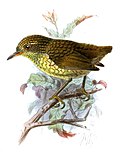| Fernwren | |
|---|---|
 | |
| Scientific classification | |
| Kingdom: | Animalia |
| Phylum: | Chordata |
| Class: | Aves |
| Order: | Passeriformes |
| Family: | Acanthizidae |
| Genus: | Oreoscopus North, 1905 |
| Species: | O. gutturalis |
| Binomial name | |
| Oreoscopus gutturalis (De Vis, 1889) | |
The fernwren (Oreoscopus gutturalis) is a species of bird in the family Acanthizidae. It is monotypic within the genus Oreoscopus. [2]
Contents
It is endemic to northern Queensland in Australia. Its natural habitats are tropical moist lowland forest and tropical moist montane forest.

